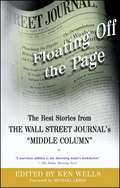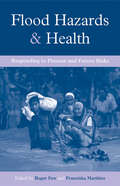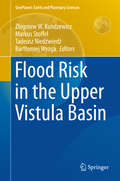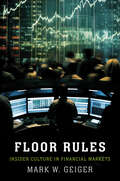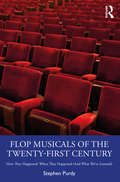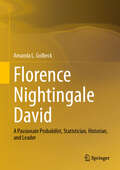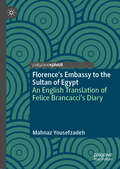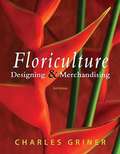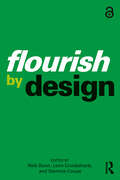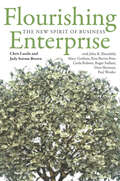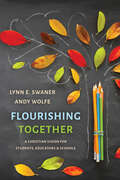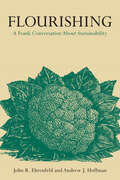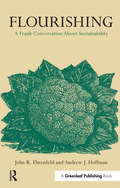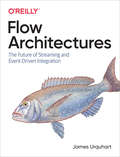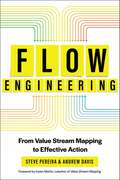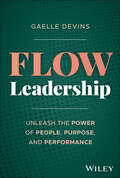- Table View
- List View
Floating Off the Page
by Ken Wells Michael LewisOn any given day, millions of Wall Street Journal readers put aside the serious business and economic news of the day to focus first on the paper's middle column (a.k.a. the A-hed), a virtual sound-bubble for light literary fare -- a short story, a tall tale, an old yarn, a series of vignettes, and other unexpected delights that seem to "float off the page." In this first-ever compendium of middle-column pieces, you'll find an eclectic selection of writings, from the outlandish to the oddly enlightening. Read about: one man's attempt to translate the Bible into Klingon sheep orthodontics, pet-freezing, and toad-smoking being hip in Cairo, modeling at auto shows, piano-throwing the fate of mail destined for the World Trade Center after 9/11 the plight of oiled otters in Prince William Sound ...and much, much more. Edited by 20-year Journal veteran Ken Wells, and with a foreword by Liar's Poker author Michael Lewis, Floating Off the Page is the perfect elixir for fans of innovative prose in all its forms and function.
Floating the Exchange Rate: In Pursuit of the Chinese Dream
by Laura Alfaro Sarah JeongIn the decades following 2005, China faced significant financial challenges. Inflation spiraled upwards and China's economy stagnated in the wake of the Global Financial Crisis. The country's leaders took an interventionist approach to weather the storm, controlling capital and exchange rates. These actions raised criticism from other nations, and in 2017 the U.S. initiated the U.S.-China Trade Wars, which enforced tariffs and requirements for increased transparency. As implications of the trade wars remained uncertain, many wondered whether the central bank would introduce further discreet steps to change the yuan. Would China's currency appreciate as substantially against the U.S. dollar as predicted by economists? And when would further change occur? The stakes were high; a freer yuan float would impact groups within and outside of China very differently. Would China's currency then be allowed to depreciate or appreciate if fundamentals required it?
Flocking: Nurturing Innovation in Your Organization
by Arie De GeusThis chapter discusses how certain institutional learning processes can accelerate innovation.
Flood Hazards and Health: Responding to Present and Future Risks
by Roger FewFlood hazards and the risks they present to human health are an increasing concern across the globe, in terms of lives, well-being and livelihoods, and the public resources needed to plan for, and deal with, the health impacts. This book is the first detailed assessment and discussion of the global health implications of flooding and future flood risk. It combines an analysis of the human health impacts of flooding with analysis of individual and societal response to those risks, and sets these findings in light of potential future increases in flood hazard as a result of climate change. Written and edited by leading researchers and practitioners on flood hazards and human health, the volume brings together findings from epidemiological, environmental, social and institutional studies, with analysis rooted in an approach that emphasizes the developmental as well as environmental causes of flood risk, and the socially differentiated nature of vulnerability and coping capacity. The first part of the book sets out the scope of the issues, and provides a detailed discussion of the global health impacts of floods and the nature of human response to the health risks posed. The second part presents new research evidence on specific health aspects of floods covering mental health, infectious diseases, local level responses and the responses of health systems - drawing on case study material from Europe, Africa, Asia and North America, including the impact of Hurricane Katrina in 2005. The conclusion synthesizes insights from the previous chapters and discusses priorities for policy, practice and research. It draws out implications for present and future adaptation to flooding, and emphasizes the need to integrate action on health with the broader agenda of long-term risk reduction. This is indispensable reading for professionals and researchers working on hazard and disaster planning, risk reduction and public health in all countries and contexts.
Flood Risk in the Upper Vistula Basin
by Markus Stoffel Zbigniew W. Kundzewicz Tadeusz Niedźwiedź Bartłomiej WyżgaThis pioneering book addresses the entirety of river flooding issues in the Upper Vistula Basin, where considerable flood generation potential exists. It analyses the factors influencing flood risk, investigates variations in observation records and discusses projections for the future and adaptation to changing risk. It serves the general interest in understanding the floods that cause massive destruction in Europe, with dozens of fatalities and tremendous material damages. This interdisciplinary book, which covers aspects of climatology, geomorphology, hydrology, and water and flood risk management, unveils the complexity of the current situation. Access to reliable and accurate information can help solve important practical problems related to flood risk reduction strategies, and is at the core of the EU Floods Directive. As such, the book offers a valuable resource for scientists, educators and practitioners involved in water management, natural disaster reduction and adaptation to climate change.
Floodgate: On the Hunt for "ThunderLizards"
by Rory Mcdonald Nicole Tempest Alix Burke Emma FrankingCase
Floodgate: On the Hunt for Thunder Lizards
by Rory Mcdonald Nicole Tempest Alix Burke Emma FrankingCase
Floodgate: On the Hunt for Thunder Lizards
by Nicole Tempest Alix Burke Emma Franking Rory McDonaldFounded in 2008, Floodgate pioneered the "micro-VC" category, a new type of investment firm that raised smaller funds and made earlier, smaller investments in technology startups than traditional venture-capital firms. By 2015, Floodgate had raised three funds totaling $225 million and achieved outsize success with investments in high profile startups like Twitter, Twitch, Cruise Automation, and Lyft. Floodgate measured success in terms of its coverage of the top 10-15 exits in any given year. These "Thunder Lizards," which had the potential to change the business landscape and grow to Godzilla-like scale, accounted for 97% of returns. With increasing competition from micro-VCs and alternatives like crowdfunding, opportunity funds, and incubators, partners Ann Miura-Ko and Mike Maples wondered how Floodgate could continue to compete successfully in a rapidly changing venture-capital landscape. Should Floodgate stay with the micro-VC model it helped invent, or raise more capital, leveraging its successful track record to make investments at the scale of more traditional VC firms? In selecting a path, they needed to consider Floodgate's dual responsibility to entrepreneurs and LPs.
Floor Rules: Insider Culture in Financial Markets (Yale Series in Economic and Financial History)
by Mark W. GeigerA compelling account of how markets really govern themselves, and why they often baffle and outrage outsiders One of the reasons many people believe financial markets are lawless and irrational—and rigged—is that they follow two sets of rules. The official rules, set by law or by the heads of the exchanges, exist alongside the unofficial rules, or floor rules—which are the ones that actually govern. Break the official rules and you may be fined or jailed; break the floor rules and you&’ll suffer worse: you will be ostracized. Regulations vary across markets, but the floor rules are remarkably consistent. This book, offering compelling stories of market disturbances in which insider rules played a key role, shows readers, without excessive moralizing, how markets really govern themselves. It is a study of the norms, customs, values, and operating modes of the insiders at the center of the financial markets that trade money, stocks, bonds, futures, and other financial derivatives. The core insiders who rule trading markets are a relatively small group who exert disproportionate influence on financial systems. Mark W. Geiger examines the historical roots of the culture of financial markets, describes the role insiders play in today&’s high finance, and suggests where this peculiar, ingrown culture is heading in an era of constant technological change.
Flop Musicals of the Twenty-First Century: How They Happened, When They Happened (And What We’ve Learned)
by Stephen PurdyFlop Musicals of the Twenty-First Century offers a provocative and revealing historical narrative of a group of musicals that cost millions, that were created by world-renowned writers and directors, and that had spectacular potential… but bombed anyway. Stephen Purdy asks the reader to consider what the legendary creators of Les Misérables, pop superstar Elton John, and wunderkind Julie Taymor have in common besides being inspired storytellers of iconic Broadway musicals. The answer is that they also all created shows that, for one reason or a dozen, flopped. This book shares the story of what can happen when formidable creative teams of sell-out musicals attempt to repeat their success but miss the mark. First-hand accounts from the cast members, backstage staff, and the creative team, combined with a wealth of secondary sources gathered from press articles, reviews, and critical commentary, offer an intriguing insight into the factors behind success and failure in the musical theatre business. This is a fascinating book for students, scholars, practitioners, and fans of musical theatre that contains thoughtful observations about luck and creative differences, botched adaptations, and alienated audiences, all of which can determine the fate of a musical.
Flop Musicals of the Twenty-First Century: Part I: The Creatives
by Stephen PurdyFlop Musicals of the Twenty-First Century offers a provocative and revealing historical narrative of a group of musicals that cost millions and had spectacular potential ... but bombed anyway. Stephen Purdy examines at length the production histories, which are all bound together by a common thread. The book focuses the lens on several seemingly infallible theatre creatives who weren’t destined to repeat their successes with the shows discussed in this volume. As such, Purdy grounds the discussion by examining what the legendary creators of Les Misérables, pop superstar Elton John, wunderkind Julie Taymor, and many others have in common besides being inspired storytellers of iconic Broadway musicals. The answer is that they also all created shows that, for one reason or a dozen, didn’t find an audience. Flop Musicals of the Twenty-First Century shares the story of what can happen when formidable creative teams of sell-out musicals attempt to re-create their success but miss the mark. This is an engaging book for students, practitioners, and fans of musical theatre that contains thoughtful observations about luck and creative differences, botched adaptations, and alienated audiences, all of which can determine the fate of a musical.
Florence Nightingale David: A Passionate Probabilist, Statistician, Historian, and Leader
by Amanda L. GolbeckThis book examines Florence Nightingale David's life, contributions, and relationships throughout her life, as well as her subsequent legacy. Florence Nightingale David (1909-1993) was the first woman professor in the world's first academic statistics department, served in various British ministries during the war from 1939-1945, and was one of the first women to chair a statistics department in a research university. In this biography, the life stories of David are used as a vehicle to explore a variety of questions surrounding culture and engagement in the statistical sciences. What does it take to succeed in an environment that is not inclusive of your demographic? How can stories be used to bring technical material to life for students and other learners? And how can a nontraditional leader succeed in challenging boundaries and moving an enterprise forward?
Florence's Embassy to the Sultan of Egypt: An English Translation of Felice Brancacci's Diary
by Mahnaz YousefzadehThis book is the first English translation of Felice di Michele Brancacci’s diary of his 1422 mission to the court of Sultan Al-Ashraf Seyf-ad-Din Barsbay of Egypt. Following the purchase of Port of Pisa in 1421, and the building of a galley system, Florence went on to assume a more active role in Levant trade, and this rich text recounts the maiden voyage of the Florentine galleys to Egypt. The text portrays the transnational experiences of Brancacci including those between the East and West, Christians and Muslims, and the ancient and modern worlds. The accompanying critical introduction discusses the unexpected motifs in Brancacci’s voyage, as well as tracing the aftershocks of what was a traumatic Egyptian experience for him. It shows that this aftershock was then measured, captured, and memorialized in the iconic image of Tribute Money, the fresco he commissioned from Masaccio, on his return to his own world in Florence.
Floriculture: Designing And Merchandising (Third Edition)
by Charles GrinerThis third edition introduces students to the career possibilities in the floral industry and provides basic instruction in the techniques of floral design and merchandising.
Florida Civics Economics & Geography
by John J. Patrick Richard C. Remy Gary E. Clayton David C. SaffellHigh School Social Studies Textbook
Florida Power & Light's Quality Improvement Program
by Christopher W.L. Hart Joan LivingstonDescribes a major electric utility's highly successful effort to institute a comprehensive quality improvement program throughout the organization. Designed to be used in a comparative analysis of the quality improvement effort described in Paul Revere Insurance Co. (A). Students learn that there is no one "right way" to build the concept of defect-prevention into an organization (as espoused by such quality experts as Deming, Juran, and Crosby). Rather, the design and implementation of a quality improvement strategy need to be tailored to such variables as the nature of demand for an organization's service, its service-delivery process, corporate culture, organizational climate, financial performance, industry structure and trends, and competing demands for organizational attention. Important topics dealt with are program implementation, problem-solving methodology/philosophical roots, rewards and recognition, measuring results, maintaining momentum, and limitations/problems.
Florida Power Light Quality Improvement (QI) Story Exercise (A)
by Christopher W.L. Hart Dan Maher Michael MontelongoFlorida Power and Light (FPL) has developed a widely acclaimed quality improvement program (QIP). This exercise leads the students through the process that a division of FPL utilized in an attempt to "improve service." Specifically, the process requires students to define "better service" in terms applicable to the utility company, determine the causes of less than perfect service, choose what causes to attack, generate a list of potential solutions, and determine a plan of action. Students employ a variety of frameworks and statistical tools to complete each step of the process. Provides a good understanding of the QIP that is attributed with taking this utility company from a state of near-crises to a highly respected operation, and that has served as a model for many other successful domestic QIP's. Designed to introduce students to the process and prepare them for class. A rewritten version of an earlier case by the same authors.
Flourish by Design
by Leon Cruickshank Nick Dunn Gemma CoupeFlourish by Design brings together a range of established and emerging voices in design research for a collection that provides original provocations on topics of global significance. It is an insightful guide to original theory and practice concerning how we can design for a better tomorrow. Featuring contributors from a diverse array of backgrounds and professions, this edited book explores the difference that design and design research can make for people, organisations, and the planet to prosper now and in the future. It offers a range of ideas and techniques through practical examples and ongoing projects showing how applied design research can respond to global challenges. Covering topics as diverse as artificial intelligence, bio-inspired materials, more-than-human design, sustainability, and urban acupuncture, it shares interdisciplinary and transdisciplinary design research not just to demonstrate what could be plausible in the near future but also to explain why it might be preferable. By sharing these despatches, this collection represents the very best of what design research can do, explaining how and why. This book is intended for a wide audience of professionals, scholars, and students in design, architecture, and public policy, as well as anyone who has an interest in how we design the world and, in turn, it designs us. The Open Access version of this book, available at www.taylorfrancis.com, has been made available under a Creative Commons Attribution-Non Commercial-No Derivatives (CC-BY-NC-ND) 4.0 license
Flourishing Enterprise: The New Spirit of Business
by Chris Laszlo Judy Sorum BrownThe notion of responsible business has infiltrated our markets, and "going green" is now a part of our mindset. But, sustainability as we know it is not enough. Flourishing-the aspiration that humans and life in general will thrive on the planet forever-should be a key goal for every business today. This is a bold concept, like sustainability was a decade ago. Just as sustainability has become a matter of course, so too will flourishing become a cornerstone of business tomorrow. How are companies to attain this big-picture goal? Drawing together decades of research along with in-depth interviews, Flourishing Enterprise argues that many strategic, organizational, and operational efforts to be sustainable reach the potential of flourishing when they incorporate one additional ingredient: reflective practices. Offering more than a dozen such practices, this book leads readers down a path to greater business success, personal well-being, and a healthier planet. Readers will find that adding reflective practices to existing business efforts does not require more work; it simply changes the way we do our work and, more importantly, the results we achieve. Cultivating emotional and spiritual health is the next frontier; this future-oriented guide develops these core competencies while stretching the ongoing conversation about profitable, sustainable business.
Flourishing Together: A Christian Vision for Students, Educators, and Schools
by Andy Wolfe Lynn E. SwanerHow do students, educators, and schools flourish together—especially in an era of increasing pressure from standardized testing, growing challenges to student mental health and well-being, and frequent educator burnout? Many schools strive toward academic achievement as their primary marker of success, but this well-meaning approach can lead to a reductionist view in which students are too often seen as statistics rather than whole human beings. Teachers, school leaders, parents, and of course students know that flourishing is a much broader and more holistic aim for education. But what is to be done? The goal of this book is to call Christian educators back to a better vision of flourishing within a robust theological framework, with the practical guidance necessary for implementation. To accomplish this, Lynn Swaner and Andy Wolfe take readers through an exploration of five essential domains identified through extensive empirical research—purpose, relationships, learning, resources, and well-being.An ideal resource for professional development and strategic planning, Flourishing Together persistently adheres to the principle that &“anything that is worth building cannot be built alone.&” Thus, the vision for flourishing here is one in which the school community is understood as an interconnected ecosystem, in which &“each one&’s flourishing is dependent on their flourishing together.&” Accordingly, teachers and administrators will be inspired and equipped to reshape their schools as places where they—alongside their students—can flourish together in a community of abundant life.
Flourishing: A Frank Conversation About Sustainability
by Andrew J. Hoffman John R. EhrenfeldFlourishing: A Frank Conversation about Sustainability invites you into a conversation between a teacher, John R. Ehrenfeld, and his former student now professor, Andrew J. Hoffman, as they discuss how to create a sustainable world. Unlike virtually all other books about sustainability, this one goes beyond the typical stories that we tell ourselves about repairing the environmental damages of human progress. Through their dialogue and essays that open each section, the authors uncover two core facets of our culture that drive the unsustainable, unsatisfying, and unfair social and economic machines that dominate our lives. First, our collective model of the way the world works cannot cope with the inherent complexity of today's highly connected, high-speed reality. Second, our understanding of human behavior is rooted in this outdated model. Driven by the old guard, sustainability has become little more than a fashionable idea. As a result, both business and government are following the wrong path—at best applying temporary, less unsustainable solutions that will fail to leave future generations in better shape. To shift the pendulum, this book tells a new story, driven by being and caring, as opposed to having and needing, rooted in the beauty of complexity and arguing for the transformative cultural shift that we can make based on our collective wisdom and lived experiences. Then, the authors sketch out the road to a flourishing future, a change in our consumption and a new approach to understanding and acting. There is no middle ground; without a sea change at the most basic level, we will continue to head down a faulty path. Indeed, this book is a clarion call to action. Candid and insightful, it leaves readers with cautious hope.
Flourishing: A Frank Conversation about Sustainability
by Andrew J. Hoffman John R. EhrenfeldThis astonishing book invites you into a conversation between a teacher, John R. Ehrenfeld, and his former student now professor, Andrew J. Hoffman, as they discuss how to create a sustainable world. Unlike virtually all other books about sustainability, this one goes beyond the typical stories that we tell ourselves about repairing the environmental damages of human progress. Through their dialogue and essays that open each section, the authors uncover two core facets of our culture that drive the unsustainable, unsatisfying, and unfair social and economic machines that dominate our lives. First, our collective model of the way the world works cannot cope with the inherent complexity of today's highly connected, high-speed reality. Second, our understanding of human behavior is rooted in this outdated model. Driven by the old guard, sustainability has become little more than a fashionable idea. As a result, both business and government are following the wrong path – at best applying temporary, less unsustainable solutions that will fail to leave future generations in better shape. To shift the pendulum, this book tells a new story, driven by being and caring, as opposed to having and needing, rooted in the beauty of complexity and arguing for the transformative cultural shift that we can make based on our collective wisdom and lived experiences. Then, the authors sketch out the road to a flourishing future, a change in our consumption and a new approach to understanding and acting. There is no middle ground; without serious change at the most basic level, we will continue to head down a false path. Indeed, this book is a clarion call to action. Candid and insightful, it leaves readers with cautious hope.
Flow Architectures: The Future Of Streaming And Event-driven Integration
by James UrquhartSoftware development today is embracing events and streaming data, which optimizes not only how technology interacts but also how businesses integrate with one another to meet customer needs. This phenomenon, called flow, consists of patterns and standards that determine which activity and related data is communicated between parties over the internet.This book explores critical implications of that evolution: What happens when events and data streams help you discover new activity sources to enhance existing businesses or drive new markets? What technologies and architectural patterns can position your company for opportunities enabled by flow? James Urquhart, global field CTO at VMware, guides enterprise architects, software developers, and product managers through the process.Learn the benefits of flow dynamics when businesses, governments, and other institutions integrate via events and data streamsUnderstand the value chain for flow integration through Wardley mapping visualization and promise theory modelingWalk through basic concepts behind today's event-driven systems marketplaceLearn how today's integration patterns will influence the real-time events flow in the futureExplore why companies should architect and build software today to take advantage of flow in coming years
Flow Engineering: From Value Stream Mapping to Effective Action
by Steve Pereira Andrew DavisTired of misalignment, friction, and stalled workflow? Flow Engineering is a practical guide to using value stream mapping techniques to align teams, unlock innovation, and optimize performance. Based on foundations from Value Stream Mapping, cybernetics, and the Toyota Production System, Flow Engineering's lightweight and iterative practices build the value, clarity, and flow required for effective collaboration and collective action. Written by Value Stream Mapping experts Steve Pereira and Andrew Davis, Flow Engineering provides a step-by-step guide for running fast-paced mapping workshops that rapidly build shared understanding. Using five key maps to facilitate collaborative &“flow conversations,&” Pereira and Davis show how teams can surface tangled process dependencies, conflicting priorities, and unspoken assumptions that grind progress to a halt. The result? A clear roadmap owned by the people doing the work to accelerate innovation cycles, optimize workflows, and achieve more effective coordination. Applicable across any industry, Flow Engineering's techniques have helped leading organizations improve critical workflows like customer onboarding, product development, and hiring.It's time to stop trying one-size-fits-all frameworks to find value, clarity, and flow to improve culture and performance. Flow Engineering meets your organization where it's at and shows you how to move it where it needs to go.
Flow Leadership: Unleash the Power of People, Purpose, and Performance
by Gaelle DevinsFlow Leadership: Unleash the Power of People, Purpose, and Performance Revolutionize your team's productivity, well-being, and organizational culture. In Flow Leadership, Gaëlle Devins—experienced executive and founder of FlowFusion—delivers a groundbreaking approach to unlocking the full potential of your team. This book introduces the 3P Assessment & Model, a powerful framework built on years of hands-on leadership, workshops, and academic research, helping leaders balance the three essential elements of high-performing teams: People, Purpose, and Performance. When these three forces align, they create a sustained state of FLOW@WORK—where individuals, teams, and entire organizations thrive. Gaëlle Devins explains how to ensure the people you lead at work feel their best, are at their best, and produce their best work. You'll learn how, when embraced by individuals, Flow Leadership naturally leads to cohesive teams united by a common purpose, where the collective outcome transcends individual contributions. When you, as a leader, shift your focus from performance to people and purpose, you will nurture the extraordinary. You'll also discover how to build a culture rooted in authenticity and resilience that attracts and retains top talent. It is time to change the workplace, putting its most valuable gem — PEOPLE — back in the centre. What You'll Learn Inside: How to lead with purpose and people-first strategies—shifting from outdated top-down models to an engaging, resilient, and high-impact leadership style. The Zone of Natural Excellence—unlocking and sustaining peak performance through a deep understanding of strengths, motivation, and skills. The 3P Assessment Model—a proven, research-backed tool that enables leaders to assess and enhance team dynamics for maximum success. Practical leadership strategies—from attracting and retaining top talent to fostering a culture of authenticity, trust, and collaboration. Essential leadership questions—the key prompts that will unlock hidden potential in your team and organization. More Than Just Theory—A Practical Guide for Immediate Impact Unlike abstract leadership books, Flow Leadership is both pragmatic and research-driven, providing real-world applications that help leaders create tangible, lasting change. Whether you're a seasoned executive, founder, or emerging leader, this book is your strategic advantage in building high-performance teams and future-proof organizations. Embrace the principles within these pages and witness how it can and will transform your career and, ultimately your life. Transform Your Leadership. Transform Your Organization. Transform Your Life. Are you ready to unlock the full potential of your people and build a thriving, purpose-driven workplace? Start reading today and experience the power of Flow Leadership.
